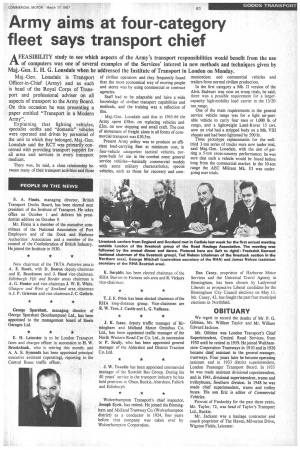Army aims at four-category fleet says transport chief
Page 63

If you've noticed an error in this article please click here to report it so we can fix it.
AFEASIBILITY study to see which aspects of the Army's transport responsibilities would benefit from the use of computers was one of several examples of the Services' interest in new methods and techniques given by Maj.-Gen. E. H. G. Lonsdale when he addressed the Institute of Transport in London on Monday.
Maj.-Gen. Lonsdale is Transport Officer-in-Chief (Army) and as such is head of the Royal Corps of Transport and professional adviser on all aspects of transport to the Army Board. On this occasion he was presenting a paper entitled "Transport in a Modern Army".
Explaining that fighting vehicles, specialist outfits and "domestic" vehicles were operated and driven by personnel of the unit to which they belonged, Maj.-Gen. Lonsdale said the RCT was primarily concerned with providing transport suppOrt for all arms and services in every transport medium.
There was, he said, a close relationship between many of their transport activities and those
of civilian operators and they frequently found that the most economical way of moving people and stores was by using commercial or contract agencies.
Staff had to be adaptable and have a wide knowledge of civilian transport capabilities and methods, and the training was a reflection of this.
Maj.-Gen. Lonsdale said that in 1965-66 the Army spent £38m. on replacing vehicles and £2m. on new shipping and small craft. The cost of movement of freight alone in all forms of commercial transport was £10.5m.
Present Army policy was to produce an efficient load-carrying fleet at minimum cost, in four-vehicle categories: tactical vehicles, purpose-built for use in the combat zone; general service vehicles—basically commercial models with some military characteristics; special vehicles, such as those for recovery and com munication; and commercial vehicles and trailers from normal civilian production.
In the first category a Mk. II version of the Alvis Stalwart was now on troop trials, he said; there was a possible requirement for a largercapacity high-mobility load carrier in the 15/20ton range.
One of the main requirements in the general service vehicle range was for a light air-portable vehicle to carry four men or 1,000 lb. of cargo, and a lightweight Land-Rover 15 cwt. now on trial had a stripped body on a Mk. VIII chassis and had been lightened by 500 lb.
Three prototype replacements for the welltried 3-ton series of trucks were now under trial, said Maj.-Gen. Lonsdale, with the aim of getting a 5-ton cross-country performance; he was sure that such a vehicle would be found before long from the commercial market. In the 10-ton range the AEC Militant Mk. HI was undergoing user trials.








































































































































































































